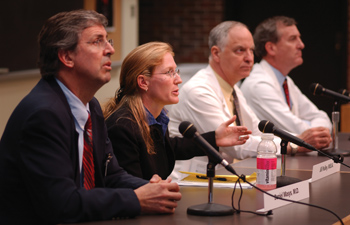
Participating in the panel discussion were, from left, Daniel Masys, M.D., Jill Pulley, M.B.A., Gordon Bernard, M.D., and Dan Roden, M.D.
photo by Anne Rayner
VUMC’s DNA Databank discussed at ethics meet
Vanderbilt University Medical Center's aim to build a massive database of linked genetic and clinical information was the focus of a lively discussion at the Fall Ethics Grand Rounds this week.
VUMC announced its plans to build the DNA Databank Resource this summer. The resource will use blood that would otherwise be discarded to obtain anonymous genetic samples. These “banked” DNA samples will be associated with clinical data extracted from medical records without information that identifies those records.
“Such a databank holds enormous potential for being used to establish and track relationships between genetics and diseases or genetics and drug response. But creating this databank raises a spectrum of critical ethical issues,” said Stuart Finder, Ph.D., co-chair of the VUMC Ethics Committee and moderator of the session.
“For instance, at one end of the spectrum, even though all of the data will be de-identified, there is the issue of whether and how to inform individuals that their DNA will be used in this way and whether and how individuals may choose to opt out,” Finder said.
“At the other end of the spectrum are questions of scientific and institutional responsibility in the face of the potential commercialization of this sort of databank sometime in the future.”
Dan Roden, M.D., director of the John A. Oates Institute for Experimental Therapeutics and principal investigator of the DNA Databank effort; Gordon R. Bernard, M.D., assistant vice chancellor for Research; and Daniel R. Masys, M.D., chair of Biomedical Informatics, described the “Facts, Features, Fallacies, and Future” of the DNA Databank effort.
The DNA Databank will be a rich research resource, Roden said, that offers institutionally managed data on a large scale to investigators interested in a wide array of diseases and drug responses.
“I think a platform like this DNA Databank is a reasonable starting point for moving toward true 'genome science,'” Roden said.
Gordon discussed efforts through focus groups to gauge community and patient reaction to such a project. The respondents were largely in favor of Vanderbilt's proposed databank project — 98 percent considered it important, 89 percent were comfortable with de-identified genetic information being used for medical studies and 91 percent agreed that the hospital should be able to use leftover blood, with all personal information removed, for ethically-approved medical research.
Masys explained the de-identification of the clinical data through a “one-way hash” into a HIPAA-compliant derivative database.
“It's important to realize that this derivative is in a sense a synthetic record set which is not the real records of any human being,” Masys said.
The synthetic record set is the basis for a searchable database that can be queried, for example, by disease, drug treatments, and laboratory values.
“One of the things that will happen out of this effort is the creation of much better tools for all of us to be able to ask questions of the clinical data that we have here,” Roden said.
Jill Pulley, M.B.A., director of the DNA Databank Resource, joined Roden, Bernard, and Masys to answer questions from the audience. Concerns about “opting in” versus “opting out” for the database, future genetic discrimination and Vanderbilt profiting from the biological material were discussed.
“This is the beginning of the conversation,” Finder said.
He encouraged audience members to send additional questions and concerns to the Medical Ethics mailbox: med.ethics@vanderbilt.edu.













